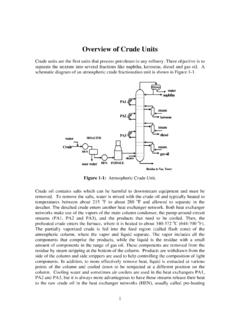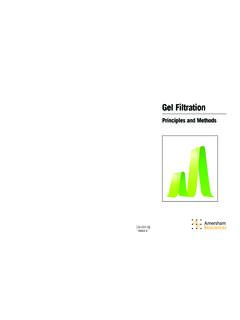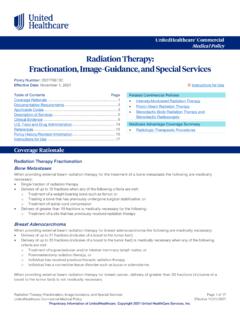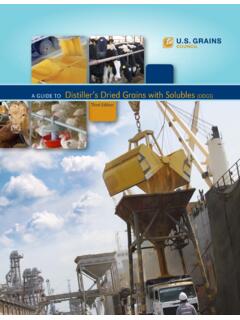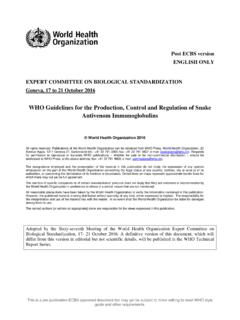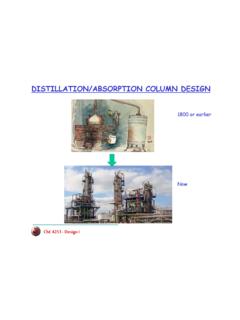Transcription of European Medicines Agency
1 The European Agency for the Evaluation of Medicinal ProductsEvaluation of Medicines for Human Use7 W estferry Circus, Canary W harf, London E14 4HB, UKTel. (+44-20) 74 18 84 00 Fax: (+44-20-) 74 18 85 45E_Mail: 2001 Reproduction and/or distribution of this document is authorised for non commercial purposes only provided the EMEA is acknowledgedLondon, 25 January 2001 CPMP/BWP/269/95 rev. 3 COMMITTEE FOR PROPRIETARY MEDICINAL PRODUCTS(CPMP)NOTE FOR GUIDANCE ONPLASMA-DERIVED MEDICINAL PRODUCTSDISCUSSION IN THE BIOTECHNOLOGY WORKING PARTY(BWP)February - March1999 TRANSMISSION TO THE CPMPM arch 1999 RELEASE FOR CONSULTATION AS ADDENDUM TO NOTEFOR GUIDANCE ON PLASMA-DERIVED MEDICINALPRODUCTS (CPMP/BWP/269/95 rev. 2)March 1999 DEADLINE FOR COMMENTSJune 1999 DISCUSSION IN THE BIOTECHNOLOGY WORKING PARTY(BWP)June 2000 TRANSMISSION TO THE CPMPJune 2000 RELEASE FOR CONSULTATIONJuly 2000 REVISION OF SECTION OF CPMP/BWP/269 2 ALBUMIN AND OTHER PLASMA-DERIVED PRODUCTSUSED IN THE MANUFACTURE AND FORMULATION OFMEDICINAL PRODUCTSJuly 2000 DEADLINE FOR COMMENTSS eptember 2000 TRANSMISSION TO CPMPJ anuary 2001 ADOPTED BY CPMPJ anuary 2001 DATE FOR COMING INTO OPERATIONJ anuary 2001 Note:Revision 3 revises section of the Note for Guidance.
2 In addition, Ph. Eur. references areupdated and the CPMP Position Paper on Plasma-derived ALT testing is P/269/95 rev. 3 EMEA 20011/31 NOTE FOR GUIDANCE ON PLASMA-DERIVED MEDICINALPRODUCTSTABLE OF and Control of Source Materials (Plasma Master File) Arising During Starting of Control of I19 ANNEX II20 ANNEX III: CPMP/117/9521 ANNEX IV: CPMP/BWP/391/9523 ANNEX V: CPMP/BWP/390/9724 ANNEX VI: CPMP/BWP/385/99 CORRIGENDUM, SEPTEMBER 199926 CPMP/BW P/269/95 rev. 3 EMEA 20012 Directive 89/381/EEC extends the scope of Directives 65/65/EEC and 75/319/EEC tomedicinal products derived from human plasma (hereinafter called "plasma-derivedproducts").Human plasma contains many proteins, the extraction and purification of which are of greatmedical importance. Although the therapeutic use of blood transfusion goes back to the turnof the century,it was not until the 1940s that that the technique of plasma fractionation ,devised by Cohn and colleagues, enabled the widespread use of medicinal products extractedfro m human in protein purification and molecular separation technology over recent yearshave made available a wide variety of products, with medical applications covering a largeand growing field, and the therapeutic value of these is unquestioned.
3 However, the potentialfor viral transmission is well recognised, and because of the large number of donations whichare pooled, a single contaminated batch of a plasma-derived product, with the contaminationpossibly originating from a single donation, can transmit viral disease to a large number ofrecipients. The recognition in the mid-1980's that plasma-derived products, in particularcoagulationfactorconcentrates, hadcausedwidespreadtransmissionofhumanim munodeficiency virus (HIV) and non-A non-B hepatitis (now recognised as mainlyhepatitis C) resulted in major changes to the manufacturing processes, with the introduction ofspecific steps to inactivate or remove these and other blood-borne viruses. However,occasional incidents of transmission of these and other blood-borne viruses have still occurredin recent years, and measures designed to minimise contamination of the starting plasma andto maximise the elimination of blood-borne viruses during production are essential to ensurethe virological safety of plasma-derived derived from human plasma can generally be divided into two groups:The first group covers products derived from single donations or from small pools of sourcematerial (<12 donors).
4 These products, for example, fresh frozen plasma and cryoprecipitatesare made and distributed by blood collection establishments and used in transfusion are subjected either to one or a few separation procedures. Their quality and safety arealmost exclusively dependent on the careful selection and control of donors, on the screeningof donations and on measures taken to minimise contamination such as second group is represented by derivatives of plasma produced on an industrial scalefrom pools of source material through various manufacturing procedures. They may be usedas therapeutic Medicines or as excipients. The quality and safety of these products rely bothon donor selection and screening of source materials, and on the choice and control of themanufacturing processes, including processes which inactivate or remove 89/381/EEC covers only plasma-derived products belonging to the second include: albumin and plasma protein solutions; immunoglobulins; coagulation factors and antiproteases; other isolated plasma fractions or combinations note for guidance covers these medicinal products derived from plasma and focuses onspecific aspects relating to the manufacture and control of these products, paying particularattention to the steps taken to minimise the risks of microbial contamination of the finishedproduct.
5 This note for guidance also covers virus-inactivated pooled plasma (large pools,>12 donors) prepared industrially. It does not cover medicinal products derived from cellularcomponents although many parts contained in this document may be P/269/95 rev. 3 EMEA 20013/31 The transmission of viruses is of particular concern. Measures taken to prevent infection bythe use of plasma-derived products include selection of donors, screening of individualdonations and starting materials for markers of infection with known viruses and validation ofthe production process for the inactivation or removal of viruses. Clinical follow up ofrecipients is the final proof of the safety of a this note for guidance it is assumed that the principles of Good ManufacturingPractice are followed as laid down in Directive 91/356/EEC, the Annex to the EC Guide toGMP on the Manufacture of products derived from human blood or human plasma andother relevant and standards for plasma-derived products are stated in the EuropeanPharmacopoeia, Monograph, "Human Plasma for fractionation ", and specific monographs forplasma-derived products (see annex I and annex II).
6 Recommendations on the suitability of donors and screening of donations are stated in theCouncil of the European Union Recommendation on the Suitability of Blood and PlasmaDonors and the Screening of Donated Blood in the European Community (98/463/EC).Other documents providing additional guidance and recommendations in the field of plasma-derived products of Europe Guide to the preparation, use and quality assurance of bloodcomponents , 4thedition which addresses the collection, preparation and use of document deals primarily with the requirements for blood and blood componentsfor use in blood transfusion and in immunohaematology; forty-third report of the WHO Expert Committee on Biological Standardisation(Technical Report Series 840, 1994) on the requirements for the collection, processingand quality control of blood, blood components and plasma derivatives. This documentcovers in four parts the requirements for the collection of source materials; single-donorand small-pool products; large-pool products; national control documents are regularly revised and reference should be made to the latest revision forcurrent types of source materials currently used in the manufacture of medicinal productsderived from human plasma are specified by the European Pharmacopoeia requirements andthe Council of the European Union, the Council of Europe and the WHO origin and means of collection differ in several )Whole blood donations are collected at blood collection establishments.
7 This material isused to prepare products made from single donations for direct transfusion while muchof the plasma is used for fractionation on an industrial scale;b)Plasma obtained by plasmapheresis is collected in plasmapheresis centres and someblood collection establishments. It is predominantly used for products manufactured onan industrial FactorsMany factors can affect the safety of blood donations in transfusion medicine. However, notall of these are relevant to medicinal products derived from human plasma manufactured onan industrial scale. Those which have implications are blood borne infections and includeviruses found in plasma which establish a viraemia such as HBV, HCV, HIV 1 and 2, HAVand parvovirus B19. In many cases such viruses can establish a persistent or latent factors of equal importance relate to the quality of the product, for example the integrityCPMP/BW P/269/95 rev.
8 3 EMEA 20014/31and biological activity of immunoglobulins and the thrombogenicity, immunogenicity andactivity of clotting factors, which can be affected by the handling and preparation of thesource materials after and Control of Source Materials (Plasma Master File) IntroductionThe source materials, the means of collecting source materials and their control are majorfactors in the quality assurance of the manufacture of biological medicinal products. Measurestaken to reduce risks include the meticulous control of source materials and their on the collection and control of source material should be documented inaccordance with the Contribution to Part II of the structure of the dossier for applications formarketing authorisation - control of starting materials for the production of blood derivatives,EC III/5272/94, and can be provided as part of the dossier as a Plasma Master File.
9 Thisinformation is required whenever a human plasma-derived product is used in a medicinalproduct whether as an active ingredient or an excipient. It should provide information onstarting materials whether received by the manufacturer of the plasma derivative as plasma oras partially fractionated intermediate and should be updated once a year. A system should bein place which enables the path taken by each donation to be traced from the donor via theblood collection establishment through to finished products and vice A Quality Assurance System for collectionThe recommendations in the Annex to the EU Guide to GMP Manufacture of productsderived from human blood or human plasma should be guidance can be found of Europe Guide to the preparation, use and quality assurance of bloodcomponents ,4thedit ion; forty-third report of the WHO Expert Committee on Biological Standardisation(Technical Report Series 840, 1994);or their subsequent establishment involved in the collection of blood or plasma used as source material forthe preparation of plasma-derived products should establish, document and maintain aneffective quality assurance system.
10 The main requirements are summarised below: the preparation of standard operating procedures; the establishment of records so that donations can be traced, , date of collection,quality control tests undertaken, with results etc., should be included; specifications for source plasma for further industrial processing into medicinalproducts; control of labelling, storage and transportation of donations; establishment of quality audits/review; appropriate Blood/plasma collection establishmentsInformation should be provided on the countries where donations are collected and theorganisations responsible for collection. An exhaustive list of names and addresses ofblood/plasma collection establishments including any subcontractors and any separate sitesfor testing of individual donations should be provided. Collection establishments should beinspected and approved by a competent authority.











